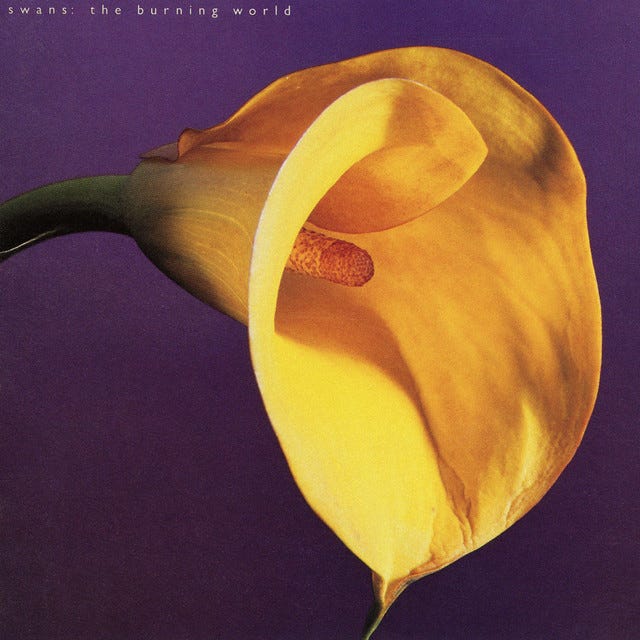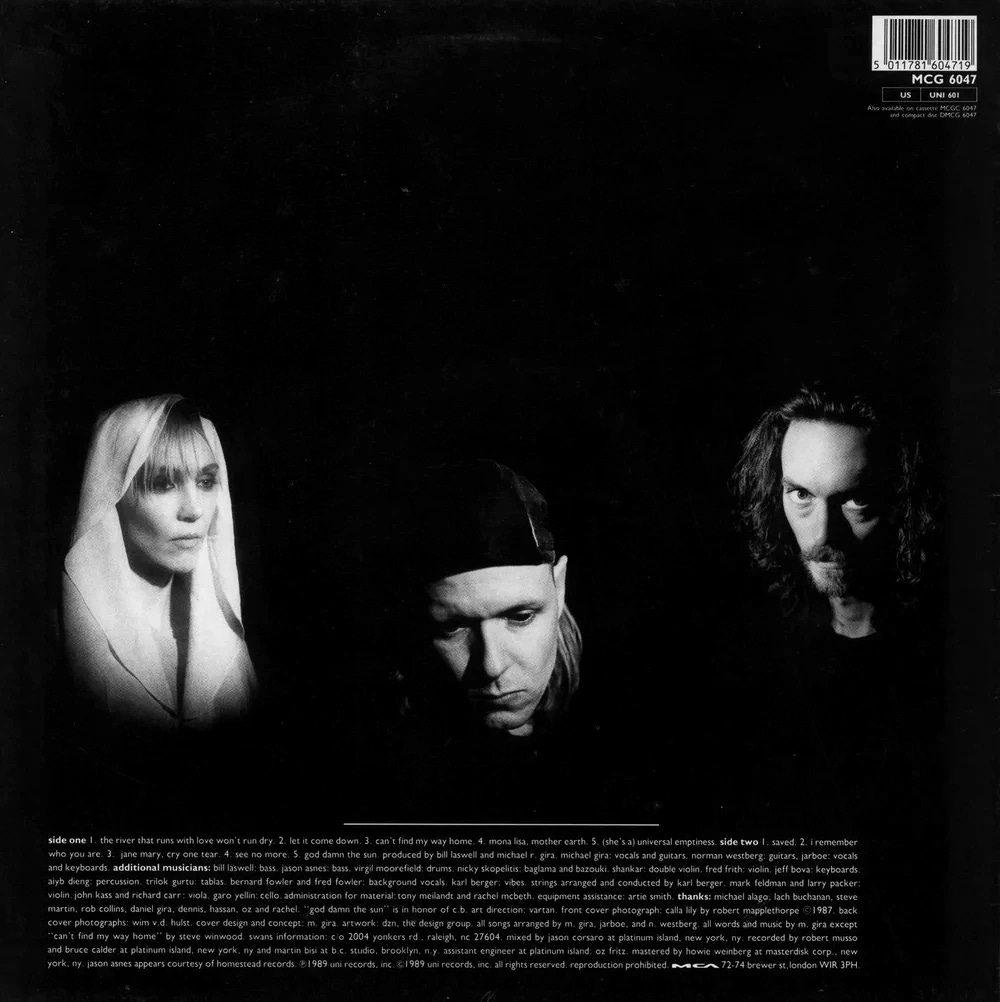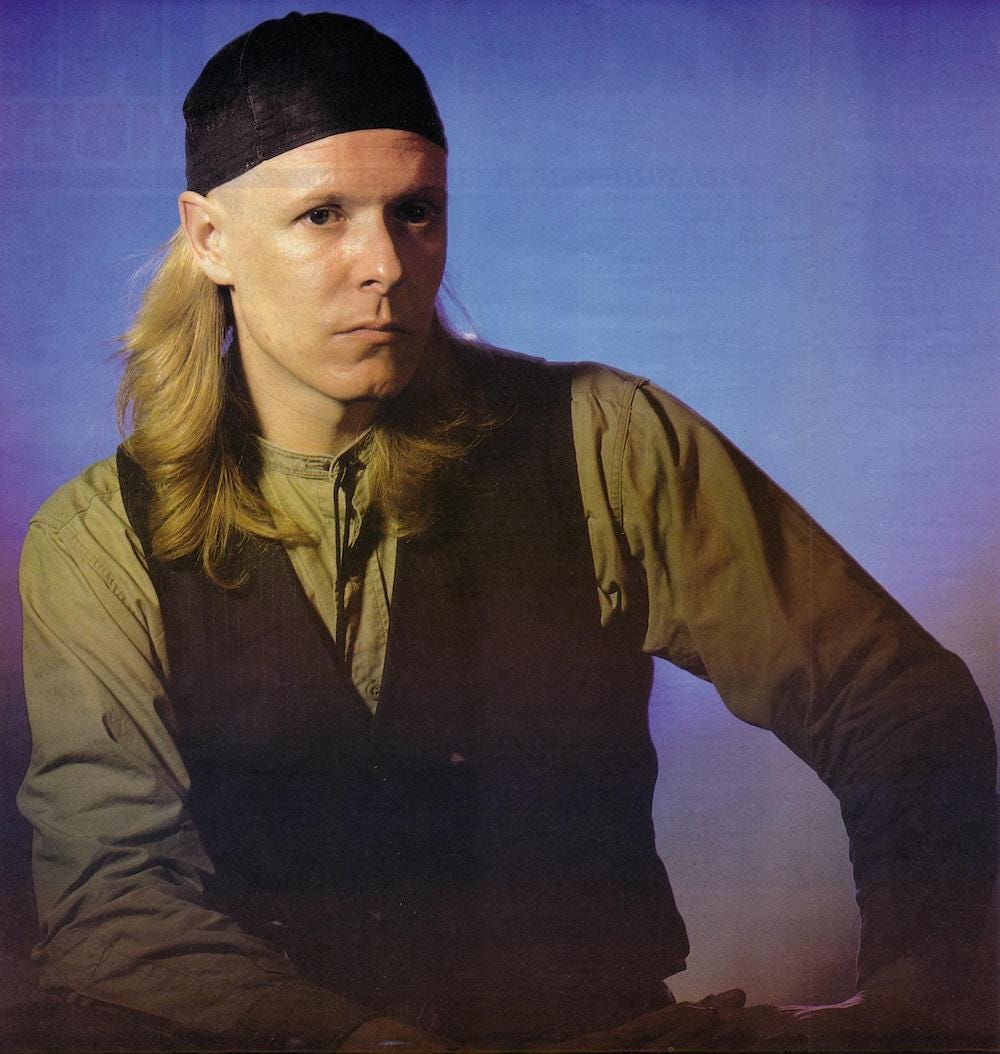SWANS: THE BURNING WORLD
ALBUM REVIEW: Swans' much-maligned 1989 major label album gets a retrospective listen. Gira Himself dislikes it intensely. It doesn't happen often, but he's totally wrong. It's a 10/10 from me.
SWANS: THE BURNING WORLD
UNI/MCA
1989
Putting 1996’s Soundtracks For The Blind’s found-soundscapes and ambient noise to one side, there are three phases to Swans, at least, to my ears.
There is Phase One, 1983-86; the terrifyingly dark, proto-industrial, slave-ship grind of Filth, Cop, Greed and Holy Money. What a hideously fruitful three years that must have been.
Each LP an immaculate exercise in claustrophobic, nauseous, bludgeoning noise.
Then there is Phase Two, 1987-94; the grim lament and lushly orchestrated songs of Children of God, The Burning World, White Light From The Mouth Of Infinity, Love of Life and The Great Annihilator.
This is where I belong.
Lastly, Phase Three, 2010-Now; the reformational grinding cosmic mantras of My Father Will Guide Me Up A Rope To The Sky, The Seer, To Be Kind, The Glowing Man, Leaving Meaning and The Beggar.
In addition to these LPs - all of which have their place and are incredible journeys to investigate - there is a multitude of live albums, demo collections and acoustic interpretations.
Don’t get me started on the adjacent projects; Skin, World of Skin and Angels of Light dig into folk-tinged song-writing, not a million miles away from The Burning World. Body Lovers/Body Haters is Gira’s post-Soundtracks For The Blind descent into more found sound cut-and-paste experimentation.
There is a ton of stuff to lose yourself in, should you be so inclined. Michael Gira and his various cohorts are incredibly prolific. Theirs is one of the most significant back catalogues in rock - and, along with Melvins and Einstürzende Neubauten, my most prized discography collection.
So, where do you start, with such a rich timeline of aural adventures? There’s an argument to say “Start at the beginning and follow their trail…”, especially if you’re prepared for the sheer heft of Phase One.
Many do the opposite - they’ve come to Swans via their current formation and have worked backwards.
I say go to Phase Two and work outwards. It’s the most accessible period of the band. They really started to focus on songwriting, making an effort to embrace tradition and mix it with the avant-garde.
The epitome of that is The Burning World.
In 1989, the moderate success (in Swans terms) of previous studio LP Children Of God and their cover single of Love Will Tear Us Apart, meant that Swans’ star was on the comparative ascent. They were clearly never going to be college rock darlings, but the cult success that bands like Dinosaur Jr, Pixies, The Lemonheads and Hüsker Dü were achieving presumably made them worth a major label gamble.
MCA signed the band and together with Bill Laswell as Producer, they set about recording The Burning World.
Musically, it’s a big jump from the transitional Children Of God; that album introduced a lull to Swans which was a real revolution.
The Burning World took that lull and moved it forward by really exploring melody. Without exception, the songs are well crafted. Each arrangement is rich and explorative without over-staying its welcome.
It’s the closest Swans ever came to “pop”.
Don’t fret - they were still a LONG way away from anything too conventional.
Gira has said he abhors the record. He struggled with Laswell and the musicians were all pretty disassociated throughout the recording, with Gira, Westberg and Jarboe being supplemented with session musicians chosen by Laswell from his pool of dependables.
I’m surprised Gira hates it so much. There are a few of my favourite Swans songs on here, and some that still find their way into his solo sets to this day.
The Burning World has been described as World Music.
That makes me feel a bit ill.
I’m not sure why it would be called that.
Yes, there’s a variety of instruments on every song that underpin the overall acoustic sound of it, but it’s not like every song is laying on a bed of pan-pipes, rattles and bongos.
Neo Folk, or Gothic Americana is probably more accurate.
The miserable fun begins with The River That Runs With Love Won’t Run Dry:
“Oh my Father was born
Beneath the water
And my mother she was born
To no one’s daughter…”
Acoustic guitars and something approaching a conventional back-beat - a rarity for the band up to this point - are both being employed to wonderful effect. There’s even a violin seguing through the different passages.
This is not the Swans you were expecting, but they manage to make convention new and exciting.
Even with the seemingly sarcastic “la la la la” chorus.
A chorus.
Let It Come Down follows, with its Morricone-esque atmosphere.
It keeps the sha-la-la-la theme going, but this time, rather than a melodic device, it’s used as an absent minded, nonchalant addition to the lyrics.
Gira is in fine vocal form; a baritone so rich that it can afford to bathe in molten gold with diamond juice for bubblebath.
The strings wail in the background, adding an Eastern vibe to the desert soundscape. The sands shift from the red rocks of Arizona to the dusty dunes of North Africa.
Jarboe takes the lead on Can’t Find My Way Home, a Blind Faith cover, surprisingly.
The acoustic instrumentation is faithful to the original, but Jarboe’s vocals give it a refined sensitivity and darkness. I’d love to know the story of how they chose this song to cover. On the face of it, an odd rockist choice.
The reality is that it is one of the album’s moments of real genius.
The upbeat Mona Lisa, Mother Earth brings Gira back.
It swims and rocks, swelling and fading in time with the lyrics:
“My mind’s an ocean
In Mona Lisa’s hand…”
Once again a non-lyric vocal device is being used, like the la-la-las - this time it’s a descending “mmmm - mmmm - mmmm - mmmm”.
The reason I mention these tropes is that they are real harmonic cornerstones that show how far from their previous work Swans were venturing.
(She’s A ) Universal Emptiness closes Side One triumphantly.
It’s the best song of the five so far; funereal guitar picking, a harpsichord and a solemn misty march of a drumbeat.
“And she holds onto a memory
Of something I never said
But she still can’t quite remember
If my eyes are blue or dead…”
You can’t help wondering if Jarboe was the muse, as they were a couple - but there’s a biblical grandeur to the song that makes me think it must be Mother Earth that’s the focus of Gira’s contempt:
“She’s the last mistake we’ll make…”.
An anthem for the global shit-storm we’re experiencing in 2024.
The almost swinging Saved opens up Side Two. You can almost imagine Michael Gira in a tuxedo, leaning forward and clicking his fingers as he sings the song into one of those big box-microphones from the 50s.
It’s almost smooth.
Almost.
I Remember Who You Are is next, and it’s another Jarboe-led vocal.
It’s a good song, but probably the most forgettable track of the LP. It lacks any stand-out motif beyond Jarboe herself, and it ponderously proceeds from start to end.
Fine as ambience, but less interesting for a focused listen.
It’s followed by Jane Mary, Cry One Tear and See No More.
The first is a dominant Gira vocal - painfully deep:
“So bury my children’s children
In a deep and lonely grave.
Anything is a cause for sorrow
That my mind and body has made.”
Talk about self-flagellation and self-loathing.
The acoustic instruments have a weirdly regal march to them up until the refrain at the end of the song, where we are treated to some tub-thumping and tom-rolling.
See No More brings back a bit of that Eastern promise we experienced in Let It Come Down before, but this time it’s the main riff rather than just the atmospherics.
To be fair, See No More could be doing the Macarena and I’d still be impatient for it to end, because the song of the album, the crescendo to The Burning World and my favourite Swansong EVER, finishes us off.
Worth the price of admission alone, ladies and gentlemen, God Damn The Sun is perfect.
I don’t say that from a point of personal opinion.
I state it as absolute proven fact.
From the apocalyptically miserable title, through the homage to loss, nostalgia and depression that the lyrics take, to the tune itself, which is so well structured it seems to breathe into your ears and release itself down your neck - it’s perfect, I tells yer.
“I gained an addiction
To drink and depression
They are mine; my only true friends
And I’ll keep them with me until the end.”
The music is a lullaby. Gently swinging from side to side, as if you’re dozing on a hammock in the seething Mediterranean sun.
The strings sweep behind the acoustic guitar.
There’s no percussion.
“I’ve got one thing to say
Before I am drunk again:
God damn the sun.
God damn anyone who says a kind word.
God damn the sun.
God damn the light it shines
And this world it shows.”
It doesn’t get much more melancholic or beautiful than that.
The song never fails.
For me, The Burning World is the first time Gira is elevated to God-like status.
Not just for his lyrics and musicality, but for his willingness to experiment and tread different paths so successfully.
As it turns out, the album was a commercial failure that saw the band sacked from the label, so what do I know?
But from the ashes of disaster grow the roses of success; the sacking instigated Gira to form Young God Records, securing Swans’ artistic integrity for ever onwards.
The band would go on to deliver Skin LPs and the incredible double-whammy of White Light… and Love of Life next. Following them up with The Great Annihilator - their most unashamedly rockiest and conventionally ‘industrial’ LP.
There would be a break for too long, where Jarboe and Gira would go their separate ways and Angels of Light would fulfil the role of Michael’s creative outlet.
In 2010, Swans Mk 2 would embark on the next phase of the band’s life.
Heavier, requiring more endurance.
Bombastic mantras that can last for hours.
It’s something to witness, for sure, but they never again got so song-orientated as they did on The Burning World. It proved a multitude of points and, despite Gira’s reluctance to give it any credibility whatsoever, showed that they could create a mature and melodic album that was instrumentally and lyrically beautiful and sensitive.
An amazing work of art.
I’ve got two copies on vinyl; my original from 1989 and the re-release, on heavier vinyl from 2014. They’re both lovely things, not least of all for the magnificent Robert Mapplethorpe cover art - a macro photograph of a lily.
As I said at the start; everything Swans/Gira has released has interest and merit. He’s a true artist and the musicians he works with are flawlessly great.
Other albums may get the cool glory, but for me, in a catalogue of amazing records, The Burning World stands out as extra special.
A fucking masterpiece.
Ave, Miserabalists!








Great article! Now I'll have to listen to it all over again. And do it very carefully. Strangely enough, this period of Swans still remains the most mysterious to me, even though it's the most straightforward. Great article! Now I'll have to listen to it all over again. And do it very carefully. Strangely enough, this period of Swans still remains the most mysterious to me, even though it's the most straightforward.
I knew that Swans review was coming and it’s not disappointing, great piece!
World music makes me ill too, and I thought it’s the third stage but i’ll give it a listen tomorrow! Keep up with your writing!